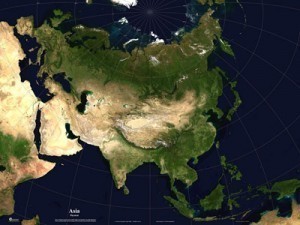What is the Size of Asia?
The size of Asia is 44,579,000 km2 (17,212,000 sq mi).  The 2009 population estimate is 3,879,000,000. The density is 89/km2 (226.sq mi. The Asian continent takes up 8.6% of the planet’s surface. 60% of the world’s population resides on the continent.
The 2009 population estimate is 3,879,000,000. The density is 89/km2 (226.sq mi. The Asian continent takes up 8.6% of the planet’s surface. 60% of the world’s population resides on the continent.
Geographical Subdivisions
The exact size of the continent is actually in dispute. The reason is that geographers cannot agree on what countries and regions to include. For the sake of convenience, the continent has been divided into regions. The following are the current regions in Asia and their approximate areas.
Note: Australia is considered a separate continent.
Central Asia
There is no agreement on what nations and regions are included here. But generally Kazakhstan is included as well as Uzbekistan, Kyrgyzstan, Tajikistan, Turkmenistan, Afghanistan, Iran and Mongolia. The size of Asia’s central territory can get confusing because parts of China are sometimes included.
East Asia
This includes the countries of Japan, Mongolia, the Korean Peninsula, Taiwan and eastern portions of China. Sometimes East Asia is geographically grouped with other Southeast Asian nations.
Northern Asia
This area refers to Siberia, Kazakhstan and Mongolia. When Northern Eurasia is used, it refers to all the former USSR regions.
Southeast Asia
The countries belonging to the mainland region are Burma, Vietnam, Thailand, Laos and Cambodia. The maritime nations of Southeast Asia area are made up of Brunei, Malaysia, the Philippines, Indonesia and Singapore. When assessing the size of Asia, this territory can get confusing; as stated, East Asia countries are often included.
Middle East or Southwest Asia
This section has numerous subdivisions. They include Anatolia (Turkey and Cyprus), the Near East (Israel, Jordan, Syria, Lebanon and Iraq). Egypt is also included in the Near East bloc even though it is part of North Africa. The Arabian Peninsula is composed of Qatar, Saudi Arabia, the United Arab Emirates, Oman, Kuwait, Yemen
and Bahrain.
The Caucasus Region
This is made up of portions of Russia, Armenia, Georgia, Azerbaijan, and parts of Afghanistan, Iran, and Pakistan.
South Asia
They include Afghanistan, India, Bangladesh, Pakistan, Sri Lanka, Nepal and the Maldives.
Note: anyone studying the size of Asia’s regions should not be surprised by the fact that countries are often included in two regions. This is to be expected owing to differing geographical interpretations.
Population Breakdown by Region
East Asia: at the People’s Republic of China the population has been estimated at 1,284,303,705; for Hong Kong it is 7,303,334; Japan, 126,974,628; Macau, 461,833; Mongolia, 2,694,432; North Korea, 22,224,195; South Korea, 48,324,000 and Taiwan, 22,548,009.
Southeast Asia: Brunei has a population of 350,898; Cambodia, 12,775,324; Indonesia, 231,328,092; Malaysia, 27,721,769; Laos, 5,777,180 and Burma, 42,238,224. The Philippines has a population of 84,525,639; Singapore, 4,452,732; Thailand, 62,354,402; East Timor, 952,618 and Vietnam, 81,098,416.
South Asia: Afghanistan has a population of 27,755,775; Bangladesh, 133,376,684; India, 1,045,845,226; Maldives, 320,165; Nepal, 25,873,917; Pakistan, 147,663,429 and Sri Lanka 19,576,783.
Biggest Countries
In terms of land area, China is the biggest at 9,584,492 km2. It is followed by India at 3,064,898 km2 and Indonesia at 1,919,440 km2. Mongolia is the fourth biggest at 1,585,000 km2.
It is not just the size of Asia’s population that is going up. In terms of economic progress, it is the fastest growing on the planet.





